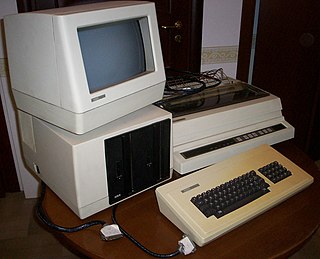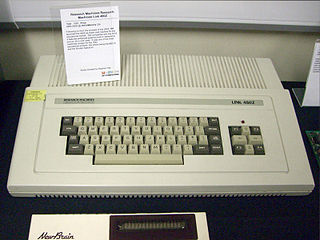
The TRS-80 Micro Computer System is a desktop microcomputer launched in 1977 and sold by Tandy Corporation through their Radio Shack stores. The name is an abbreviation of Tandy Radio Shack, Z80 [microprocessor]. It is one of the earliest mass-produced and mass-marketed retail home computers.

Amstrad was a British consumer electronics company, founded in 1968 by Alan Sugar. During the 1980s, the company was known for its home computers beginning with the Amstrad CPC and later also the ZX Spectrum range after the Sinclair deal, which led it to have a substantial share of the PC market in Britain. In the following decade it shifted focus towards communication technologies, and its main business during the 2000s was the manufacture of satellite television set-top boxes for Sky, which Amstrad had started in 1989 as the then sole supplier of the emerging Sky TV service.

CP/M, originally standing for Control Program/Monitor and later Control Program for Microcomputers, is a mass-market operating system created in 1974 for Intel 8080/85-based microcomputers by Gary Kildall of Digital Research, Inc. CP/M is a disk operating system and its purpose is to organize files on a magnetic storage medium, and to load and run programs stored on a disk. Initially confined to single-tasking on 8-bit processors and no more than 64 kilobytes of memory, later versions of CP/M added multi-user variations and were migrated to 16-bit processors.

The Amstrad PCW series is a range of personal computers produced by British company Amstrad from 1985 to 1998, and also sold under licence in Europe as the "Joyce" by the German electronics company Schneider in the early years of the series' life. The PCW, short for Personal Computer Word-processor, was targeted at the word processing and home office markets. When it was launched the cost of a PCW system was under 25% of the cost of almost all IBM-compatible PC systems in the UK, and as a result the machine was very popular both in the UK and in Europe, persuading many technophobes to venture into using computers. The series is reported to have sold 1.5 million units. However the last two models, introduced in the mid-1990s, were commercial failures, being squeezed out of the market by the falling prices, greater capabilities and wider range of software for IBM-compatible PCs.

The Big Board (1980) and Big Board II (1982) were Z80 based single-board computers designed by Jim Ferguson. They provided a complete CP/M compatible computer system on a single printed circuit board, including CPU, memory, disk drive interface, keyboard and video monitor interface. The printed circuit board was sized to match the Shugart 801 or 851 floppy drive. This allowed attachment to up to two 8 inch or 5 1/4 inch floppy disk drives. The Big Board II added a SASI interface for hard disk drives, enhancements to system speed and enhancements to the terminal interface.

The Xerox 820 Information Processor is an 8-bit desktop computer sold by Xerox in the early 1980s. The computer runs under the CP/M operating system and uses floppy disk drives for mass storage. The microprocessor board is a licensed variant of the Big Board computer.

Tiki-100 was a desktop home/personal computer manufactured by Tiki Data of Oslo, Norway. The computer was launched in the spring of 1984 under the original name Kontiki-100, and was first and foremost intended for the emerging educational sector, especially for primary schools. Early prototypes had 4 KB ROM, and the '100' in the machine's name was based on the total KB amount of memory.
Kaypro Corporation was an American home and personal computer manufacturer based in Solana Beach in the 1980s. The company was founded by Non-Linear Systems (NLS) to compete with the popular Osborne 1 portable microcomputer. Kaypro produced a line of rugged, "luggable" CP/M-based computers sold with an extensive software bundle which supplanted its competitors and quickly became one of the top-selling personal computer lines of the early 1980s.

The Tandy 2000 is a personal computer introduced by Radio Shack in September 1983 based on the 8 MHz Intel 80186 microprocessor running MS-DOS. By comparison, the IBM PC XT used the older 4.77 MHz Intel 8088 processor, and the IBM PC/AT would later use the newer 6 MHz Intel 80286. Due to the 16-bit data bus and more efficient instruction decoding of the 80186, the Tandy 2000 ran significantly faster than other PC compatibles, and slightly faster than the PC AT. The Tandy 2000 was the company's first computer built around an Intel x86 series microprocessor; previous models used the Zilog Z80 and Motorola 6809 CPUs.

The Amstrad PC1512 was Amstrad's mostly IBM PC-compatible computer system, first manufactured in 1986. Next year a slight updated version named PC1640 was introduced. It was also marketed as PC6400, and Sinclair PC500. Schneider branded machines for the German market also exists.

The SV-328 is an 8-bit home computer introduced by Spectravideo in June 1983. It was the business-targeted model of the Spectravideo range, sporting a compact full-travel keyboard with numeric keypad. It had 80 KB RAM, a respectable amount for its time. Other than the keyboard and RAM, this machine was identical to its little brother, the SV-318.
The Apricot PC is a personal computer produced by Apricot Computers, then still known as Applied Computer Techniques or ACT. Released in late 1983, it was ACT's first independently developed microcomputer, following on from the company's role of marketing and selling the ACT Sirius 1, and was described as "the first 16-bit system to be Sirius-compatible, rather than IBM-compatible", indicating the influence that the Sirius 1 had in the United Kingdom at the time.
The Mac286 was an Intel 80286-based MS-DOS coprocessor expansion card for one of Apple Computer's first expandable Macintosh computers, the 1987 Macintosh II. It was developed by Phoenix Technologies under contract to Apple Computer and sold by AST Research in an effort to close the gap between the Macintosh and IBM PC computing worlds. AST also introduced the related Mac86 card for the Macintosh SE.

The Osborne Executive is the successor of the already commercially successful Osborne 1 portable computer by Osborne Computer Corporation. The Executive consists of a collection of the good features from the Osborne 1 and fixes some of its predecessor's perceived flaws.
Atari 8-bit computer peripherals include floppy drives, printers, modems, and video game controllers for Atari's 8-bit computer family, which includes the 400/800, XL, XE, and XEGS.
The Kay 1024 was a Russian ZX Spectrum clone introduced in 1998. Created by the NEMO company of St. Petersburg, it has 1024 KB of RAM. It was a rival to Scorpion ZS 256, having a slightly lower price. It offered a controller for a PC keyboard and HDD, but not for floppy disks. Adding a General Sound card was easy, and the CPU had a 7 Mhz turbo mode.

The LINK 480Z was an 8-bit microcomputer produced by Research Machines Limited in Oxford, England, during the early 1980s.
The Commodore PC compatible systems are a range of IBM PC compatible personal computers introduced in 1984 by home computer manufacturer Commodore Business Machines.

The history of laptops describes the efforts, begun in the 1970s, to build small, portable Personal Computers that combine the components, inputs, outputs and capabilities of a Desktop Computer in a small chassis.

The Olivetti M19 was a personal computer made in 1986 by the Italian company Olivetti. It has an 8088 at 4.77 or 8 MHz and 256–640 KB of RAM. The BIOS is Revision Diagnostics 3.71. In the UK, it was sold by Acorn Computers as the Acorn M19, with additional software also available via Acorn. In France, it was available as the Persona 1300, sold by LogAbax.













